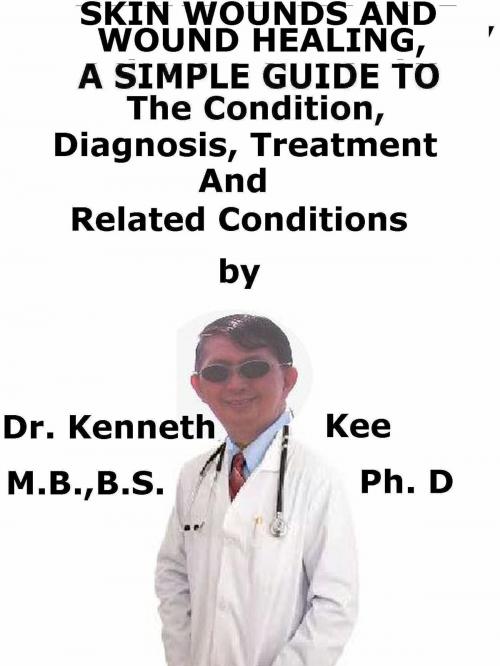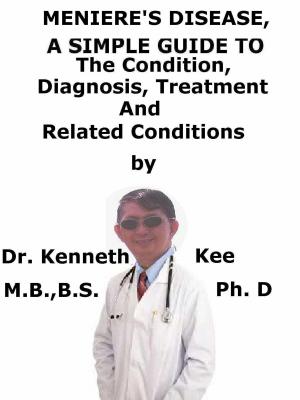Skin Wounds And Wound Healing, A Simple Guide To The Condition, Diagnosis, Treatment And Related Conditions
Nonfiction, Health & Well Being, Medical, Specialties, Dermatology, Health, Ailments & Diseases, Skin| Author: | Kenneth Kee | ISBN: | 9781370741403 |
| Publisher: | Kenneth Kee | Publication: | December 16, 2016 |
| Imprint: | Smashwords Edition | Language: | English |
| Author: | Kenneth Kee |
| ISBN: | 9781370741403 |
| Publisher: | Kenneth Kee |
| Publication: | December 16, 2016 |
| Imprint: | Smashwords Edition |
| Language: | English |
A wound is a disorder resulting from injury to living tissue induced by a cut, blow, or other impact, normally one in which the skin is cut or broken.
Wounds are injuries that sever the skin or other body tissues.
They often happen because of an accident, but surgery, sutures, and stitches also produce wounds.
Minor wounds normally are not severe, but it is important to clean them.
Serious and infected wounds may need first aid followed by a visit to the doctor
Wounds occur when there is:
a. Cuts by a sharp object such as a knife
Cuts carve the skin open.
This produces bleeding and pain.
Cuts need to be cleaned, closed, and covered with a bandage so they do not get infected.
b. Punctures are stab wounds.
They can be superficial ones, such as from a splinter or deep ones, such as from stepping on a nail.
Puncture wounds injure and bleed.
c.Abrasions are surface loss of skin and are less serious than cuts
d. Bruises are produced by broken blood vessels that bleed into the tissue under the skin.
A bruise causes the skin to be black and blue or red.
e. Burns can be produced from dry heat (fire), moist heat (steam, hot liquids), electricity, chemicals, and the sun (sunburn).
f. Insect Bites and Stings
g. Bed sores particularly in the elderly
Wounds can be divided into:
A. Superficial Wounds
a. Epidermis is injured
b. Healing happens with scar formation
c. Wounds have alterations in pigmentation
B. Deep Wounds
I. Without Loss of Tissue
These wounds can be closed with sutures or surgical tape.
The stability and strength of wound can be recovered.
There is development of connective tissues.
Granulation tissue will be quickly covered by epithelium.
II. With Loss of Tissue
The doctor will want to
1. Stop the bleeding if the wound is bleeding a lot.
2. Clean the wound with disinfectant.
This will get rid of dirt and other small objects and reduce the chance of infection.
3. Look in the wound for foreign objects like dust or glass splinters.
4. Explore (probe) or close the wound under local anesthesia.
Closing the wound:
The laceration may need stitches, staples, other treatments to seal the wound if:
1.It is deep or bleeds a lot.
2.The wound is wide open or
3.The wound is in a region that moves a lot, such as the hands, feet, and joints.
Stitches also stop the wound from getting infected.
Stitches may reduce the amount of scarring.
If the wound is too old, it should not be stitched.
Wound healing procedure can be divided into 4 distinct phases:
Hemostasis,
Inflammatory,
Proliferation,
Remodeling.
Wound treatment requires:
1.Surgical debridement and irrigation of wounds
2.Systemic and topical antibiotic for infections
3.Clean Wound suture
4.Delayed wound closure.
Methods are present to increase the healing of the clean wound.
After a wound is in a steady clean condition, a decision must be made about permitting it to heal by natural processes or increasing healing with a surgical treatment.
Surgical methods are:
1. Skin grafting,
2. Application of bioengineered skin substitutes, and
3. Use of flap closures
TABLE OF CONTENT
Introduction
Chapter 1 Skin Wounds and Wound Healing
Chapter 2 Causes
Chapter 3 Symptoms
Chapter 4 Diagnosis
Chapter 5 Treatment
Chapter 6 Prognosis
Chapter 7 Bed sores
Chapter 8 Skin Injuries
Epilogue
A wound is a disorder resulting from injury to living tissue induced by a cut, blow, or other impact, normally one in which the skin is cut or broken.
Wounds are injuries that sever the skin or other body tissues.
They often happen because of an accident, but surgery, sutures, and stitches also produce wounds.
Minor wounds normally are not severe, but it is important to clean them.
Serious and infected wounds may need first aid followed by a visit to the doctor
Wounds occur when there is:
a. Cuts by a sharp object such as a knife
Cuts carve the skin open.
This produces bleeding and pain.
Cuts need to be cleaned, closed, and covered with a bandage so they do not get infected.
b. Punctures are stab wounds.
They can be superficial ones, such as from a splinter or deep ones, such as from stepping on a nail.
Puncture wounds injure and bleed.
c.Abrasions are surface loss of skin and are less serious than cuts
d. Bruises are produced by broken blood vessels that bleed into the tissue under the skin.
A bruise causes the skin to be black and blue or red.
e. Burns can be produced from dry heat (fire), moist heat (steam, hot liquids), electricity, chemicals, and the sun (sunburn).
f. Insect Bites and Stings
g. Bed sores particularly in the elderly
Wounds can be divided into:
A. Superficial Wounds
a. Epidermis is injured
b. Healing happens with scar formation
c. Wounds have alterations in pigmentation
B. Deep Wounds
I. Without Loss of Tissue
These wounds can be closed with sutures or surgical tape.
The stability and strength of wound can be recovered.
There is development of connective tissues.
Granulation tissue will be quickly covered by epithelium.
II. With Loss of Tissue
The doctor will want to
1. Stop the bleeding if the wound is bleeding a lot.
2. Clean the wound with disinfectant.
This will get rid of dirt and other small objects and reduce the chance of infection.
3. Look in the wound for foreign objects like dust or glass splinters.
4. Explore (probe) or close the wound under local anesthesia.
Closing the wound:
The laceration may need stitches, staples, other treatments to seal the wound if:
1.It is deep or bleeds a lot.
2.The wound is wide open or
3.The wound is in a region that moves a lot, such as the hands, feet, and joints.
Stitches also stop the wound from getting infected.
Stitches may reduce the amount of scarring.
If the wound is too old, it should not be stitched.
Wound healing procedure can be divided into 4 distinct phases:
Hemostasis,
Inflammatory,
Proliferation,
Remodeling.
Wound treatment requires:
1.Surgical debridement and irrigation of wounds
2.Systemic and topical antibiotic for infections
3.Clean Wound suture
4.Delayed wound closure.
Methods are present to increase the healing of the clean wound.
After a wound is in a steady clean condition, a decision must be made about permitting it to heal by natural processes or increasing healing with a surgical treatment.
Surgical methods are:
1. Skin grafting,
2. Application of bioengineered skin substitutes, and
3. Use of flap closures
TABLE OF CONTENT
Introduction
Chapter 1 Skin Wounds and Wound Healing
Chapter 2 Causes
Chapter 3 Symptoms
Chapter 4 Diagnosis
Chapter 5 Treatment
Chapter 6 Prognosis
Chapter 7 Bed sores
Chapter 8 Skin Injuries
Epilogue















